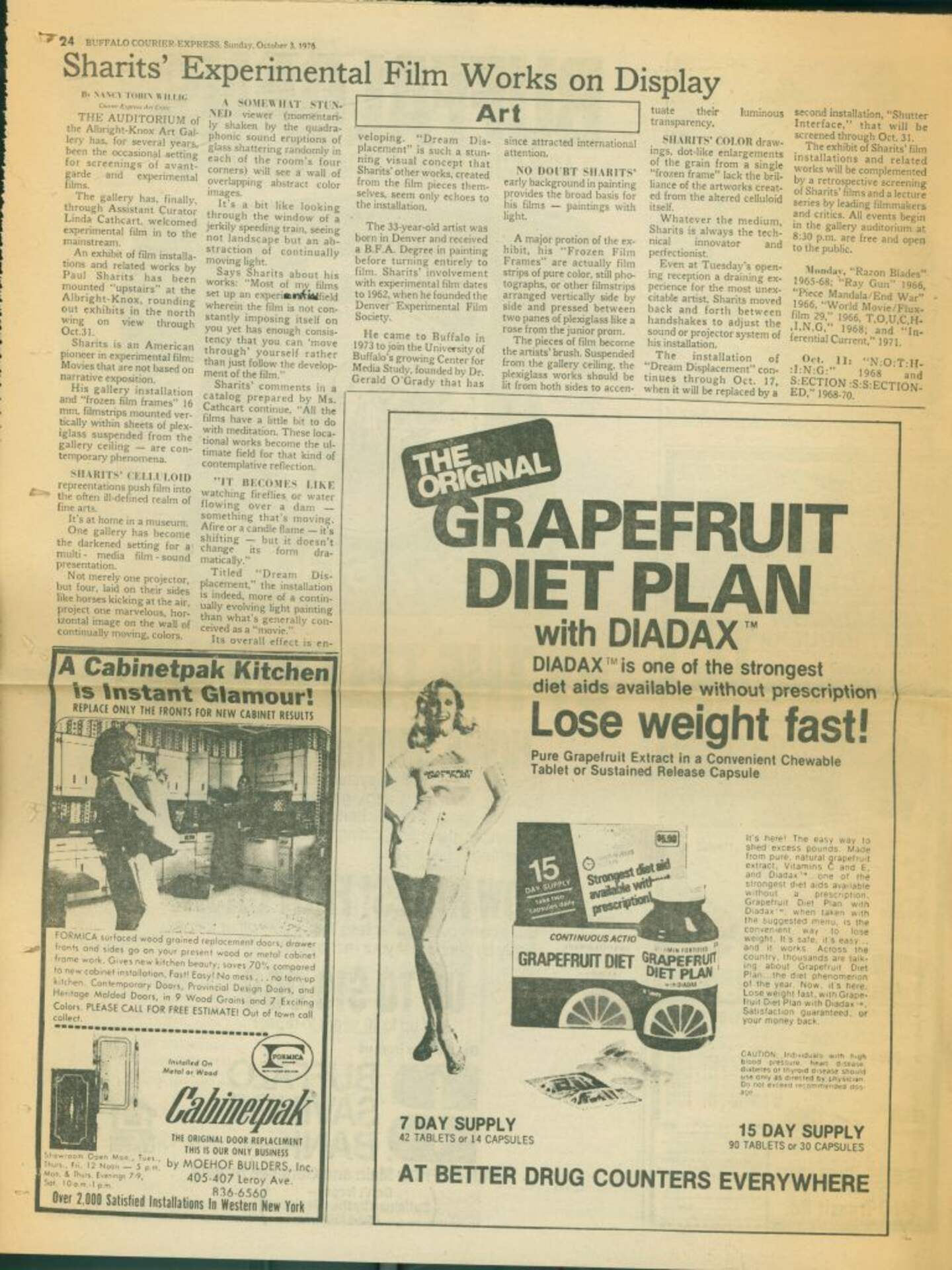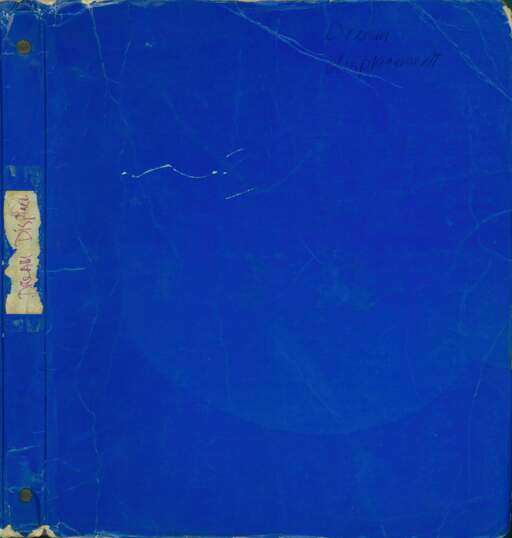Paul Sharits (1943-1993)Sharit's Experimental Film Works on Display (With Note)
typed on newsprint
15 x 12 inches
Gift of Christopher and Cheri Sharits, 2006
Sharits’ Experimental Film Works on Display
By Nancy Tobin Willig
THE AUDITORIUM of the Albright-Knox Art Gallery has, for several years, been the occasional setting for screenings of avant-garde and experimental films.
The gallery has, finally, through Assistant Curator Linda Cathcart, welcomed experimental film in to the mainstream.
An exhibit of film installations and related works by Paul Sharits has been mounted “upstairs” at the Albright-Knox, rounding out exhibits in the north wing on view through Oct.31.
Sharits is an American pioneer in experimental film: Movies that are not based on narrative exposition.
His gallery installation and “frozen film frames” 16 mm. filmstrips mounted vertically within sheets of plexiglass suspended from the gallery ceiling—are contemporary phenomena.
SHARITS’ CELLULOID repreentations push film into the often ill-defined realm of fine arts.
It’s at home in a museum.
One gallery has become the darkened setting for a multi-media film-sound presentation.
Not merely one projector, but four, laid on their sides like horses kicking at the air, project one marvelous, horizontal image on the wall of continually moving, colors.
A SOMEWHAT STUNNED viewer (momentarily shaken by the quadraphonic sound eruptions of glass shattering randomly in each of the room’s four corners) will see a wall of overlapping abstract color images.
It’s a bit like looking through the window of a jerkily speeding train, seeing not landscape but an abstraction of continually moving light.
Says Sharits about his works: “Most of my films set up an experim[entied] field wherein the film is not constantly imposing itself on you yet has enough consistency that you can ‘move through’ yourself rather than just follow the development of the film.”
Sharits’ comments in a catalog prepared by Ms. Cathcart continue, “All the films have a little but to do with meditation. These locational works become the ultimate field for that kind of contemplative reflection.
“IT BECOMES LIKE watching fireflies or water flowing over a damn — something that’s moving. Afire or a candle frame—it’s shifting—but it doesn’t change its form dramatically.”
Titled “Dream Displacement,” the installation is indeed, more of a continually evolving light painting than what’s generally conceived as a “movie.”
Its overall effect is enveloping. “Dream Displacement” is such a stunning visual concept that Sharits’ other works, created from the film pieces themselves, seem only echoes to the installation.
The 33-year old artist was born in Denver and received a B.F.A. Degree in painting before turning entirely to film. Sharits’ involvement within experimental film dates to 1962, when he founded the Denver Experimental Film Society.
He came to Buffalo in 1973 to join the University of Buffalo’s growing Center for Media Study, founded by Dr. Gerald O’Grady that has since attracted international attention.
NO DOUBT SHARITS’ early background in painting provides the broad basis for his films—paintings with light.
A major protion of the exhibit, his “Frozen Film Frames” are actually film strips of pure color, still photographs, or other filmstrips arranged vertically side by side and pressed between two panes of plexiglass like a rose from the junior prom.
The pieces of film become the artists’ brush. Suspended from the gallery ceiling, the plexiglass works should be lit from both sides accentuate their luminous transparency.
SHARITS’ COLOR drawings, dot-like enlargements of the grain from a single “frozen frame” lack the brilliance of the artworks created from the altered celluloid itself.
Whatever the medium, Sharits is always the technical innovator and perfectionist.
Even at Tuesday’s opening reception a draining experience for the most unexcitable artist, Sharits moved back and forth between handshakes to adjust the sound or projector system of his installations.
The installation of “Dream Displacement” continues through Oct. 17, when it will be replaced by a second installation, “Shutter Interface,” that will be screened through Oct. 31.
The exhibition of Sharits’ film installations and related works will be complemented by a retrospective screening of Sharits’ films and a lecture series by leading filmmakers and critics. All events begin in the gallery auditorium at 8:30 p.m. are free and open to the public.
Monday, “Razor Blades” 1965-68; “Ray Gun” 1966, “Piece Mandala/End War” 1966, “World Movie/Fluxfilm 29” 1966, “T,O,U,C,H,I,N,G,” 1968; and “Inferential Current,” 1971.
Oct. 11: “N:O:T:H:I:N:G:” 1968 and “S:ECTION:S:S:ECTIONED,” 1968-70.


